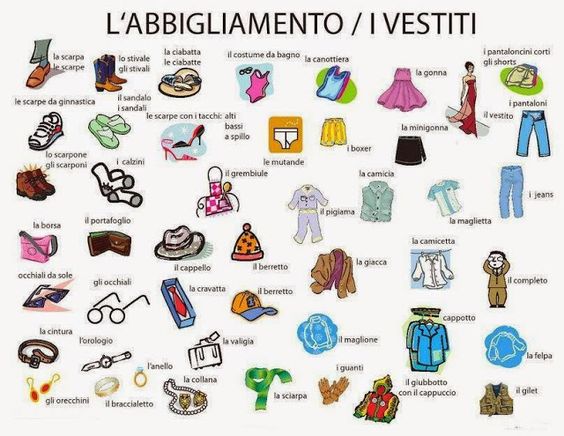3.5: La moda e i verbi della seconda coniugazione
- Page ID
- 147697
leggiamo
|
Sono le ore sedici e il signor Mattarella e la signora Winfrey escono dal museo, Cappelle Medicee. Signora Winfrey: “Grazie mille! Cosa fa adesso signor Mattarella?” Signor Mattarella: “ Vado in albergo e poi incontro mia figlia. Mia figlia ama fare spese. Qui a Firenze ci sono dei negozi molto belli.” Signora Winfrey: “Mi piace molto la moda italiana. Tutti gli italiani sono molto eleganti.” Signor Mattarella: “Firenze è la città dove c’è stata la prima sfilata di moda. Quale stilista preferisce?” Signora Winfrey: “È difficile scegliere….” Signor Mattarella: “Se vuole, posso stare un po’ con Lei. Possiamo andare in via de' Tornabuoni, dove ci sono dei negozi molto belli.” Signora Winfrey: “È molto gentile, ma oggi non posso.” Signor Mattarella: “Va bene, da che parte va? Signora Winfrey: “Verso San Marco”. Signor Mattarella: “Allora faccio un po’ di strada con Lei”. |
It is 4 pm and Mr Mattarella and Mrs Winfrey leave the museum, Medici Chapels. Mrs Winfrey: "Thank you very much! What are you doing now, Mr Mattarella?" Mr. Mattarella: "I'll go to the hotel and then I 'll meet my daughter. My daughter loves to shop here in Florence there are very nice boutiques." Mrs Winfrey: "I really like Italian fashion. All Italians are very elegant." Mr. Mattarella: "Florence is the city where the first fashion show took place. Which stylist do you prefer?" Mrs Winfrey: "It’s hard to choose..." Mrs Winfrey: "That’s very kind, but we can’t today." Mr Mattarella: "All right, which way are you going? Mrs Winfrey: "Towards San Marco". Mr Mattarella: "Then I’ll go a little further with you". |
Florence as fashion capital https://www.visittuscany.com/en/idea...n-in-florence/
|
Obiettivi:
2nd conjugations Verbs
Modal verbs
Vocabulary about clothes
The second group of verbs ends in -ERE.
As we learned, we need to take off the end ERE and add the ending that correspond to the subject (the person who does the action). Here
Io legg-O
tu legg-I
Lei legg- E
noi legg-IAMO
voi legg-ETE
loro legg-ONO
Useful verbs
Cadere = to fall
Chiedere= to ask for
Conoscere = to know
Decidere = to decide
Leggere= to read
mettere= to put
perdere= to lose
prendere= to take
promettere = to promise
raggiungere= to reach
rispondere= to reply, answer
rompere = to break
scrivere= to write
spendere= to spend
vedere= to see
vendere= to sell
vincere= to win
vivere= to live
MODAL VERBS
DOVERE = to have to, must
POTERE= to can
VOLERE= to want
are three very important helping verbs. They add a modality to say:
if you have to ... devo andare (I need to go, I must go)
if you can go... posso andare (I can go) (may)
if you want to go... voglio andare
|
DOVERE (have to, must, nee) devo devi deve dobbiamo dovete devono |
POTERE (can) posso puoi può possiamo potete possono |
VOLERE (want) voglio vuoi vuole vogliamo volete vogliono |
Leggiamo!
|
Giuditta e Artemisia camminano per le strade di Firenze e passano davanti alla casa di Dante. Dante Alighieri è un famoso poeta nato a Firenze nel 1265. È famoso in tutto il mondo per la Divina Commedia. Artemisia: “Giuditta conosci la storia della Divina Commedia?” Giuditta: “So che è un poema. È la storia di un viaggio fantastico nell’oltretomba.” Artemisia: “Anch’io non conosco bene la storia. Devo leggere quel libro! Qui in via Alighieri puoi vedere anche la Torre della Castagna. Questa torre si chiama così perché i governatori di Firenze usavano (used to utilize) le castagne (chestnuts) per contare i voti.” Giuditta: “Che cosa sono quelli?” Artemisia: “ Sono degli stemmi. Firenze è famosa per i suoi artigiani. Gli artigiani sono abili lavoratori che creano dei prodotti speciali. Questi stemmi rappresentano le squadre o arti di questi artigiani. Vedi qui abbiamo l’arte della lana. Nell’arte della lana ci sono gli artigiani che raccolgono la lana e fanno dei vestiti caldi e morbidi. Qui vedi lo stemma dell’arte del cambio. Nell’arte del cambio ci sono gli artigiani che commerciano le pietre preziose e che scambiano i soldi. Giuditta: “Ah, è simile allo stemma dei Medici…” Artemisia: “Hai ragione! Questo è lo stemma dell’arte dei vinattieri. C’è un bicchiere di vino.
Questa è l’arte dei corazzai e spadai. Gli artigiani costruiscono armature e elmi. Questa è l’arte dei chiavaioli. Qui gli artigiani fanno chiavi, serrature, ma anche chiodi e ganci. Questa è l’arte dei fabbri: i fabbri sono gli artigiani del ferro. La tenaglia che c’è nello stemma serve a tenere nel fuoco il pezzo di ferro da battere con il martello. L’arte di calimala invece è dedicata ai mercanti di stoffe. Interessante, vero? Firenze è già da molto tempo all’avanguardia per la produzione di molti beni materiali. Per questo è una città ricca e bella! Qui vicino c’è la chiesa di Orsanmichele e ogni arte ha qui la statua del suo Santo Protettore". |
Giuditta and Artemisia are walking the streets of Florence and pass by Dante’s house. Dante Alighieri is a famous poet born in Florence in 1265. He is famous all over the world for the Divine Comedy. Artemisia: "Giuditta, do you know the story of the Divine Comedy?" Giuditta: "I know it’s a poem. It’s the story of a fantastic journey to the underworld." Artemisia: "I also don’t know the story well. I have to read that book! Here in Via Alighieri you can also see the Torre della Castagna. This tower is so called because the governors of Florence used chestnuts to count votes." Giuditta: "What are those?" Artemisia: "They are coats of arms. Florence is famous for its craftsmen. Craftsmen are skilled workers who create special products. These coats of arms represent the teams or arts of these craftsmen. See here we have the art of wool. In the art of wool there are artisans who collect wool and make warm and soft clothes. Here you see the coat of arms of the art of exchange. In the art of exchange there are craftsmen who trade precious stones and exchange money. Giuditta: "Ah, it is similar to the coat of arms of the Medici..." This is the art of armor and swordsmen. Craftsmen build armor and helmets. This is the art of locksmiths. Here craftsmen make keys, locks, but also nails and hooks. This is the art of blacksmiths: blacksmiths are the artisans of iron. The pincer in the coat of arms is used to hold in the fire the piece of iron to beat with the hammer. The calimala art is dedicated to cloth merchants. Interesting, isn’t it? Florence has long been at the forefront of the production of many material goods. For this reason it is a rich and beautiful city! Nearby there is the church of Orsanmichele and every art has here the statue of its Patron Saint". |
https://www.worldhistory.org/Dante_Alighieri/ https://it.wikipedia.org/wiki/Torre_della_Castagna
https://www.tuscanypeople.com/antica...-lana-firenze/ https://it.wikipedia.org/wiki/Arte_della_Lana https://www.tuscanypeople.com/antica...ambio-firenze/ https://it.wikipedia.org/wiki/Arte_del_Cambio https://it.wikipedia.org/wiki/Arte_dei_Vinattieri https://it.wikipedia.org/wiki/Arte_dei_Chiavaioli https://it.wikipedia.org/wiki/Arte_dei_Fabbri https://en.wikipedia.org/wiki/Arte_di_Calimala https://it.wikipedia.org/wiki/Arte_dei_Mercatanti http://www.italianrenaissance.org/orsanmichele/
|
CONOSCERE E SAPERE
|
CONOSCERE conosco conosci conosce conosciamo conoscete conoscono |
SAPERE so sai sa sappiamo sapete sanno |



